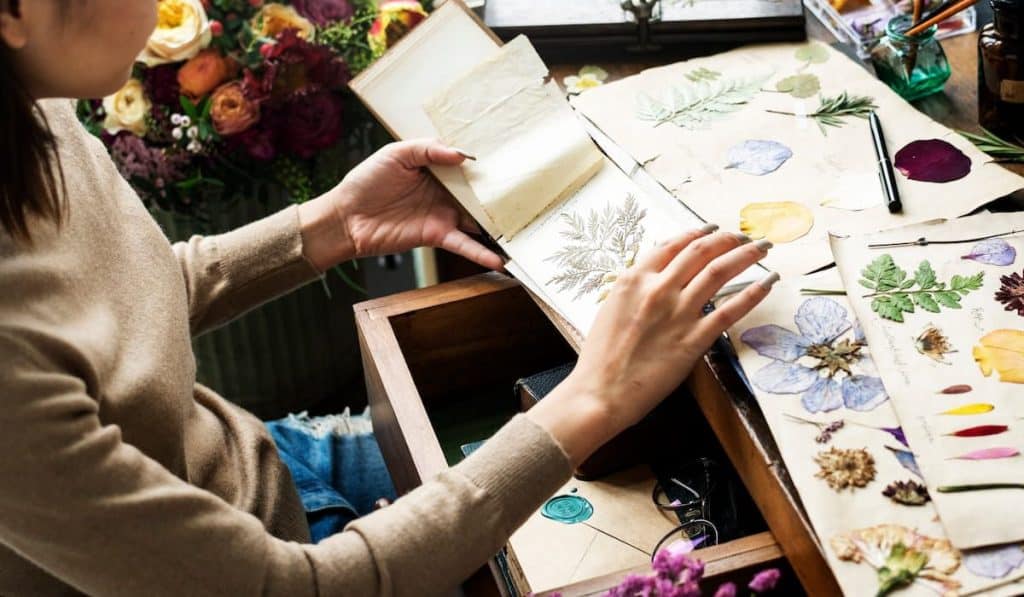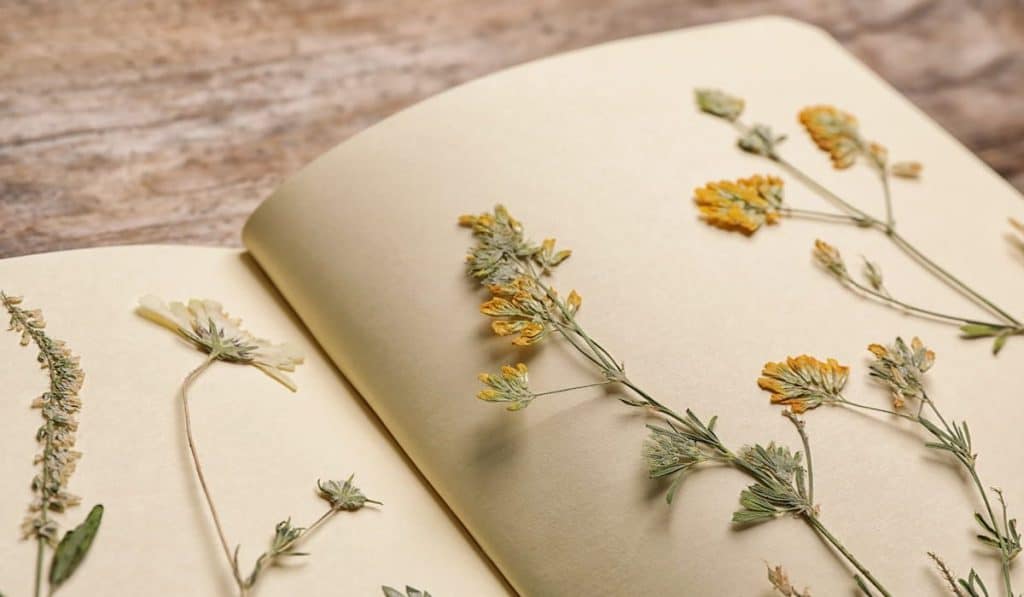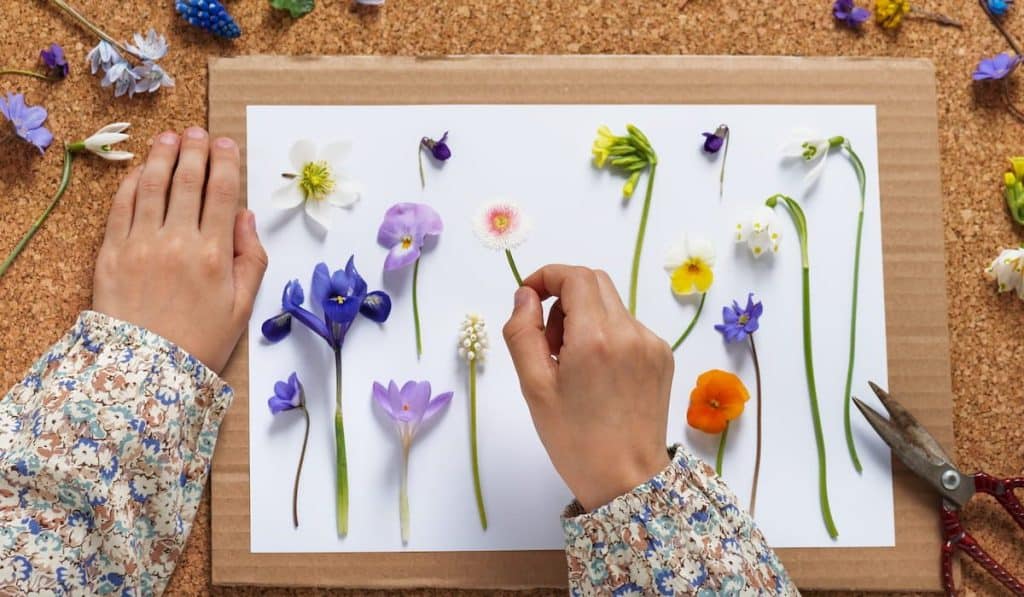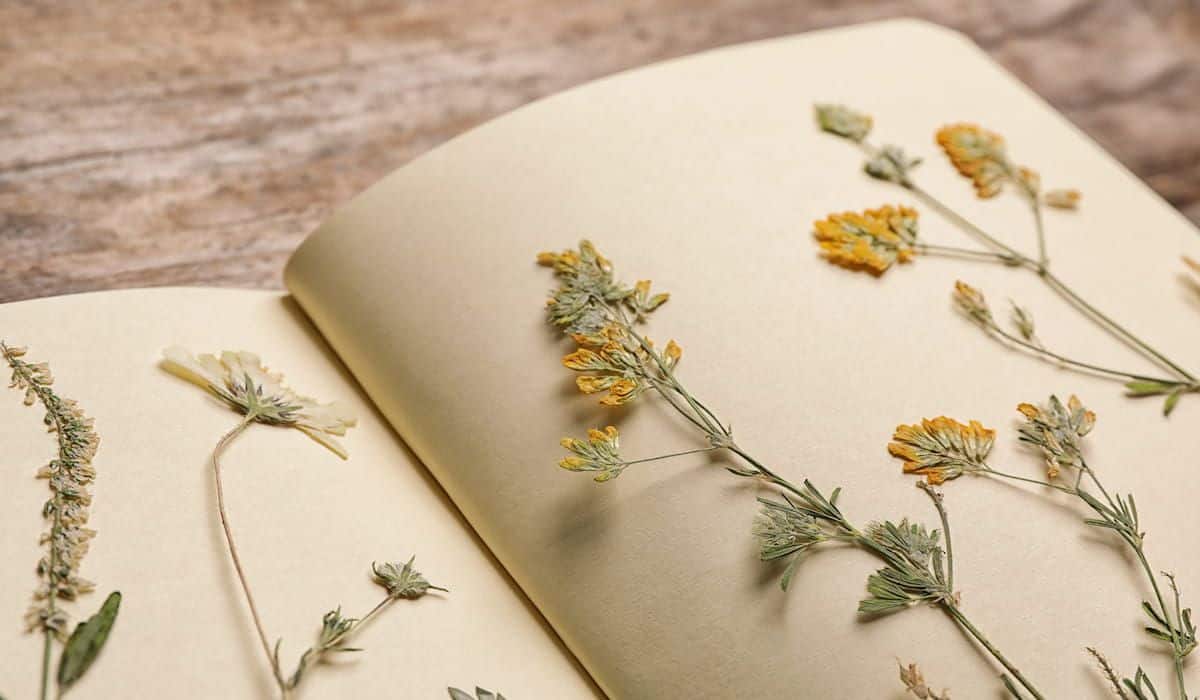If you are looking for a refined and artistic hobby that will keep you in tune with nature, you can do no better than taking up the delightful pastime of flower pressing.
Pressed flowers have been an art form for thousands of years and across many cultures and are a wonderful way of appreciating and preserving the beauty of fresh flowers.
Flower pressing not only can create eye-catching displays but is also an effective way of curating and journaling your study of nature.
In this article, we will equip you with the essentials for making flower pressing a thriving hobby.
Join us to look at the techniques you can use and the types of projects that can be undertaken to beautify your surroundings and delight recipients of your handiwork.
We will also provide all the essential online and offline resources needed to help you get your flower pressing hobby successfully underway.

What is Flower Pressing?
Flower pressing, also known as pressed flower craft or pressed flower art, is the art of flattening and desiccating fresh flowers to preserve them so that they can be used in creative projects or for cataloging. Flower pressing can also be used to preserve flowers from a gifted bouquet or bridal posy to make stunning mementos.
Biologists often keep a plant press or flower press to hand on field trips to preserve specimens for archival projects when they are fully preserved.
The pressing process can be undertaken via several methods and though the flattened foliage and blooms will have altered colorings, the flowers usually retain their character and charm. Though it is a relatively simple hobby, a good technique produces stunning results and hobbyist flower pressers enjoy experimenting and refining their skills.
An Illustrious Hobby with a Noble History
Flower pressing goes back centuries and has a history that is steeped in the exotic and aristocratic. It is believed to have first appeared as a tangible craft in 16th century Japan, where artisans would create stunning lacquered artworks using large quantities of delicate and filamentous blooms.
Known as Oshibana (literally “pressed flowers”), these artistic pieces caught the attention of European merchants and traders who brought examples of this fascinating art to the courts and estates of European royalty and nobility.
It soon became an exclusive and admired artform with botanical specimens and sprays framed in glass.
Over time flower pressing became popular in North America too, and by the Victorian era, pressed flower art had matured into a mainstream pastime on both sides of the Atlantic.
The actress and later Princess Grace Kelly was an ardent flower pressing hobbyist. Its success was certainly down to its accessibility and affordability with the items needed for a basic flower pressing being easy to come by.
Many fine specimens from these times have survived and have provided great insights into not only recreations in pastimes, but also botanical species that have become rare or extinct.
Hobbyist flower pressing is now undertaken all over the world with the top countries for flower pressing including Japan, Germany, the United States of America, and the United Kingdom.

5 Things that Make Flower Pressing a Great Hobby!
We think that flower pressing makes a great hobby for anyone looking for a simple creative outlet that produces satisfying results. Here are our top 5 reasons to start flower pressing.
- Flower pressing is an affordable hobby
When a hobby is cost-effective it becomes so much easier to maintain and develop your skills by experimentation.
Flower pressing is easily accessible because the upfront costs of equipment (outlined further on) are low, and the only consumables are flowers and foliage which you can often pick for free.
Of course, there are specialist papers and presses, but the basics can be readily assembled yourself, meaning that there’s every reason to get on and have a go!
- Flower pressing is versatile
A great thing about hobby flower pressing is that it makes a great springboard to other satisfying projects.
If you already enjoy art as a hobby, pressed flowers can make an interesting addition to your work.
You can also experiment with leaves and herbs for striking vintage herbarium or curate local or exotic flora in scrapbooks or reference works.
Further on we list some of the ways you can extend your flower pressing into a range of creative projects.
- Hobby flower pressing gets you to learn about and enjoy nature
John Keats said, “a thing of beauty is a joy forever” and we are sure that when you start flower pressing you will start to appreciate not only the beauty but the detail of the natural world.
Your search for the perfect wildflower specimen to press will probably take you on happy trails and treks and you will start to learn about your local annuals and perennials and how flowers fit into their local ecosystem.
- Both children and adults can enjoy flower pressing
We think hobbies are best when they can be shared, and flower pressing is a delightful way of sharing something positive between the generations.
Little feet can do all the legwork of foraging for plants and flowers while seniors can guide them in arranging their flowers and operating a press.
Children will not only benefit from learning the names of flowers and plants but also gain a creative skill that can last a lifetime. If you are encouraging your child to press flowers it is important to supervise them as some plants are poisonous.
- Do it well and your flower pressing projects could make you an Etsy star!
If you become an industrious hobbyist, you may find you have lots of completed flower pressing projects on your hands.
There’s no need to let them pile up and gather dust, sell your pressed flowers online or at crafts fairs for some profit that you can plow back into your hobby!
How does Flower Pressing Work?
Your flower pressing hobby is more nuanced than taking a flower and jamming it in the middle of a heavy book.
If flower pressing is not done with care you will probably end up with a rotted mess.
Nuances for successful flower pressing include your choice of bloom and the steps you take before pressing the flower.
Preparing Flowers Properly for Pressing is Key to Success with Your New Hobby
By considering the type of flowers you press and how you prepare them, you can get better results with hobby flower pressing.
- Start with dry flowers: Pick your blooms on a dry day in the late morning after the dew has evaporated from them.
- Flowers are best when picked just before full bloom.
- Let your flowers start to dry naturally: this helps them to open more before you work with them.
- Get your flowers flat before pressing them: You can do this by trimming the stem, bulk, or seed pods from the back of the flower, or even taking the flower apart and pressing its parts separately. This is often a good strategy for flowers with large heads like hydrangeas. Rosebuds are often best when sliced in half and arranged for pressing. Trumpet flowers like daffodils are best pressed sideways. A lot of the work of flower pressing is imaginative reconstruction so feel free to experiment!
Here are 4 methods You Can Use for Hobby Flower Pressing
- Using a plant or flower press
This is the standard method for drying flowers and foliage under pressure. Once flattened and dried you can work with them in any way you want.
A typical flower press consists of a solid wooden (beech wood), or dense card outer boards with straps that can be tightened to compress the flowers within.
An alternative classic design uses nuts and bolts in the four corners of the press which can be tightened to the desired pressure. Some flower presses are elegantly engraved or decorated for a personal touch.
Within the press, your flowers and plants are layered between sheets of absorbent paper. Using this method, you can press multiple flowers at once.
Once a flower press is loaded with your desired blooms, the sandwich of paper and flowers is tightened up and left in a dry place. Paper changes will be necessary at regular intervals as you wait for your flowers to dry, if you do not change the paper you will get mold.
Patience is key as the complete process can take up to a month to complete.
- Flower pressing with books
Books are a traditional and cheap way of pressing flowers. If you have a collection of heavy volumes to hand, you now have a reason to put them to some use. Use an old book that you don’t mind becoming stained.
Bigger books mean that you can press multiple flowers at once. Once you have selected your blooms prepare them by laying them flat on parchment paper. Open the book and line the pages with parchment paper.
Place your flower between the pages and close the book. It then can be weighed down with other heavy books or weights for three to four weeks or until they feel dry and papery.
- Pressing flowers with an iron
Flower pressing cannot get any easier than doing the job with a steam iron, meaning that there is nothing to stop you from starting your hobby today.
All that is needed is some parchment paper to place your blooms on. Cover your arrangement with another layer of paper and take your iron to it.
Give the steam a miss and use a low setting. Apply the iron for 15 seconds at a time and let the paper and flowers cool down.
Repeat this until your flowers are dried.
- Pressed flowers in the microwave
If you can’t wait weeks for some paper dried flowers for your projects, you can also use a microwave to create crispy dried flowers in a matter of seconds.
It’s hard to believe until you try it for yourself, but yes, microwaves have proven a pro-hack for pressed flowers in volume when and where needed. The color retention is great too!
The method is simple and cheap, though you can purchase a microwave flower press for the job. Petals or whole flowers can be placed with folded paper towels or parchment paper and weighed down with a plate and a glass of water.
Short low-temperature bursts are all that is needed until you get the desired results.
Types of Flower Pressing and Projects You Can Make Part of Your Hobby
- Japanese flower pressing, also known as Oshibana
Given the Japanese’s love of floral arrangements and blossoms, such as during the annual Hanami (花見) cherry blossom festivals, it is unsurprising that flower pressing is a treasured discipline and art form.
This form of flower pressing is often executed on a large scale with expansive and intricate pictures formed from the pressed petals and stems.
A completed piece of pressed flower art is known as “an Oshibana”. Some of the early practitioners of this art form were Samurai warriors who would press and dry flowers to exercise discipline.
If you are going to start or extend your flower pressing hobby, it is well worth keeping an eye on what the artisans are achieving in Japan, as they are the innovators of this art and have developed lots of new techniques.
Leading Japanese pressed flower artists like Nobuo Sugino, work out of studios and workshops and use a range of vacuum preservation and color enhancement techniques that greatly extend the longevity of the pressed flower designs.
Oshibana has many groups and societies you can join or obtain advice and information from. We have included a number of them below.
- Pressed flower decoupage
Dried flowers are a perfect medium for a range of pressed flower projects. This decorative art usually uses layers of colorful paper that are covered with lacquer or varnish to build up a striking sealed finish.
With decoupage, any object can be your canvas. Pressed petals can be fanned across furniture, keepsake boxes, or frames with Mod Podge or spray varnish used to seal the layers one by one.
Expansive designs like tabletops or dressers may need a layer of glass across them to protect the flowers from deteriorating.
- Framed art
One of the most popular types of pressed flower hobby is the creation of framed art. It is an excellent way of preserving floral bouquets, posies, and other floral keepsakes. You can also frame herbs and other botanicals.
If you love design, you will find that creating floating designs by layering your pressed flowers between two plates of glass, will create a very contemporary look.
Alternatively, you can source vintage frames or make your own to display the flowers you have pressed. There are many different types of material you can mount your pressed flowers on for added impact including, parchment paper, linen or cotton, Japanese Washi paper, or silks.
It’s important to remember that as the flowers are natural, prolonged exposure to natural light is likely to cause the pigments in the flowers to fade with time.
If your color pops are a priority it is possible to enhance the color of pressed flowers with specialist pigments, dyes, and pens.
- Cards and stationery
Pressed flowers are a classic addition to stationery projects, and it is easy to find lots of fun ways of personalizing cards, invitations, and envelopes.
If you are an avid flower collector who presses large volumes of flowers, stationery designs could be not only a creative outlet for your hobby but a lucrative one too.
Many people who want unique or personalized wedding stationery or decorations look for pressed flowers, so you may end up with some decent profit from your efforts.

Assembling the Toolkit for Your Pressed Flower Hobby
Every hobby requires its tools of the trade and flower pressing is no different.
Your selection of items will be dependent on what you intend to do with the flowers. The great thing is that most items are affordable, and you probably have many in your home already.
Specialist tools like varnishes, pigments, and craft knives can be sourced once you have decided on the types of projects you are going to do.
Here is a typical list of supplies for pressing flowers:
- A worktable with good lighting and perhaps a magnifying glass will help you work on your pressed flower projects in an organized manner.
- Your flower press, steam iron, or microwave if you want to get the job done quickly.
- Heavy books, weights, or bricks are worth having to hand. Even if you are using a press, the additional weight may be welcome.
- Paper: decent quality absorbent paper is a luxury of flower pressing. Many people use paper towels or newspapers, but the results are not as good as those you can achieve with blotting paper or parchment paper.
- Cardstock for mounting your pressed or framed flowers.
- Scissors
- Craft knives can be used to dissect flowers and remove stems and sepals more precisely than with scissors.
- Cutting mats are used to precisely prepare your flowers and other materials with a craft knife.
- Varnish can be used in liquid form or as a spray.
- PVA glue or Mod Podge is great for having on hand to glue down and seal your pressed flowers. However, it is important to remember that they are not waterproof.
- Foam brushes and paintbrushes of varying width can be used to glue and varnish your flowers.
- Ruler or set square
- Pencils
- A sheet of glass can be placed over projects that are in progress so that your petals and leaves remain undisturbed.
- Resin: Epoxy resin can be used to set and seal pressed flowers. This is one of the best ways of preserving them. Clear casting resin can be used to produce transparent plaques and coasters with your florals sealed within them.
- Tweezers are handy for arranging delicate petals and tendrils in your project. Avoid using your fingers as they can add moisture to the dried flowers.
- Embellishments. Traditional details like tiny ribbons are still used for vintage pressed flower displays. Keep a small box with pieces of fabric, lace, sequins, or anything else that comes to mind for use in your projects.
What are the Best Flowers for Pressing?
Here are some excellent choices of flowers for flower pressing that will give reliable results:
- Cosmos flowers are brightly colored daisy-like annuals that you can grow quickly and easily from seed. They are related to sunflowers and are a great pick for pressing because they lay flat well and hold their shape when you press them.
- Pansies are a staple for hobbyists who need their pressed flowers to hold their color. Pansies come in so many vibrant hues that you will have a kaleidoscope of color to work with.
- California poppy is great for pressing because it is colorful but thin leaves dry and flatten out quickly.
Organizations and Resources for Hobbyist and Professional Flower Pressers
- The Philadephia Horticultural Society often features pressed flowers as part of its annual shows. The website has a section for flower pressing with an introductory tutorial.
- The Pressed Flower Guild is a UK based flower pressing group affiliated with the Royal Horticultural Society. Residents in the UK can participate in meetups and conferences and submit their projects for publication online.
- The Worldwide Pressed Flower Guild brings together pressed flower enthusiasts and artists from all over the world. Their website and resources are well worth a visit as this Japanese found organization offers full membership which includes exclusive resources, workshops, and a newsletter. You can find them on Facebook too.
- The International Pressed Flower Art Society has been active for over 20 years and works to promote pressed flower art as both a hobby and a creative discipline.
Rounding up
So, there you have it. All you need to springboard into releasing your creativity through the floral medium!
Our best advice to you is to have a go, experiment, and start creating beautiful flower art with your new flower pressing hobby.
Is there anything we have missed out or tips and tricks you would like to share? If so, let us know your thoughts in the comments section below!





